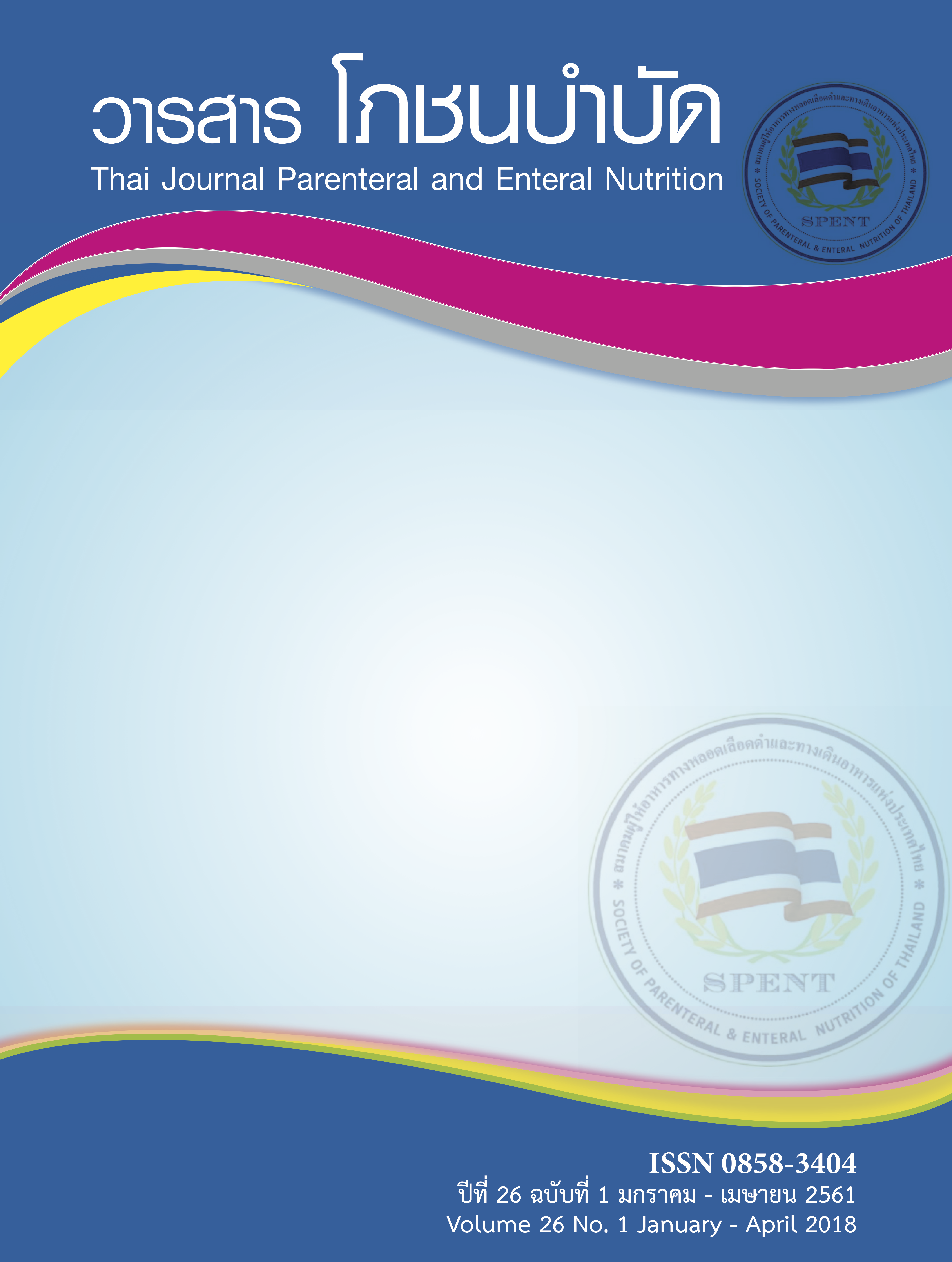ผลกระทบจากสัดส่วนของ Non-Protein Calories : Nitrogen และปัจจัยเสี่ยงที่เกี่ยวข้องทั้งหมดต่อการเกิดภาวะน้ำดีคั่งจากการได้รับสารอาหารทางหลอดเลือดในทารกทีมีน้ำหนักแรกเกิดน้อยกว่า 1,500 กรัม
คำสำคัญ:
PN, PNAC, NPcal:N ratioบทคัดย่อ
บทนำ: ภาวะน้ำดีคั่งจากสารอาการทางหลอดเลือดดำ (Parenteral Nutrition-Associated Cholestasis : PNAC) ในทารกเกิดจากปัจจัยเสี่ยงหลายอย่าง โดยเฉพาะสัดส่วนของพลังงานจากอาหารที่ไม่ใช่โปรตีนต่อไนโตรเจนที่ได้จากโปรตีน (Non-Protein Calories : Nitrogen Ratio; NPcal:N ratio)
วัตถุประสงค์: เพื่อศึกษาความสัมพันธ์ของ NPcal:N ratio และปัจจัยเสี่ยงที่เกี่ยวข้องทั้งหมดกับการเกิด PNAC ของทารกแรกเกิด
วิธีการ: การศึกษา retrospective cohort ในทารกแรกเกิดที่มีน้ำหนักแรกเกิดที่มีน้ำหนักแรกเกิดน้อยกว่า 1,500 กรัม และได้สารอาหารทางหลอดเลือดดำ (Parenteral Nutrition, PN) อย่างน้อย 14 วันขึ้นไประหว่างปี พ.ศ.2552-2559 โดยผู้ป่วยถูกแบ่งเป็น 2 กลุ่ม คือ กลุ่มเกิดและไม่เกิด PNAC วิเคราะห์ปัจจัยเสี่ยงที่มีนัยสำคัญทางสถิติด้วย logistic regression แล้ววิเคราะห์ต่อด้วย Receiver Operating Characteristic curve (ROC curve)
ผลการศึกษา: ทารกแรกเกิดที่ได้ PN จำนวน 976 คน มีผู้ป่วยตรงตามเกณฑ์การคัดเข้าจำนวน 238 คนและในจำนวนนี้พบ PNAC 78 คน (ร้อยละ 8) วิเคราะห์ด้วย multivariable logistic regression โดยวิธี backward พบว่า NPcal:N ratio ที่มากกว่า 125:1 (OR = 1.953; CI 1.018-3.745) ระยะเวลาที่ได้ PN 14 วันขึ้นไป (OR=1.080; CI 1.041-1.120) และอายุที่เริ่มได้สารอาหารผ่านทางเดินอาหาร (Enteral Nutrition, EN) มากกว่า 5 วันหลังคลอด OR = 1.097; CI 1.008-1.194) มีความสัมพันธ์กับการเกิด PNAC อย่างมีนัยสำคัญทางสถิติ และเมื่อวิเคราะห์ด้วย ROC curve ได้เท่ากับร้อยละ 70.6
บทสรุป: แนวทางในการลดความเสี่ยงต่อการเกิด PNAC จะต้องไม่ให้สัดส่วนของ NPcal:N เกิน 125:1 ร่วมกับลดระยะเวลาที่ได้รับ PN ลงให้น้อยกว่า 14 วัน และเริ่มให้ผู้ป่วยได้รับ EN ที่เร็วขึ้นภายใน 5 วันหลังคลอด
เอกสารอ้างอิง
Nghiem-Rao TH, Dahlgren AF, Kalluri D, Cao Y, Simpson PM, Patel SB. Influence of gestational age and birth weight in neonatal cholesterol response to total parenteral nutrition. J Clin Lipidol 2016;10:891-7.
Boullata JI, Holcombe B, Sacks G, Gervasio J, Adams SC, Christensen M, et al. Parenteral nutrition safety committee, American society for parenteral and enteral
nutrition. standardized competencies for parenteral nutrition order review and parenteral nutrition preparation,including compounding: The ASPEN model. Nutr Clin Pract 2016;31:548-5.
Rangel SJ, Calkins CM, Cowles RA, Barnhart DC, Huang EY, Abdullah F, et al. Parenteral nutritionassociated cholestasis: an American pediatric surgical association outcomes and clinical trials committee systematic review. J Pediatr Surg 2012;47:225-40.
Lauriti G, Zani A, Aufieri R, Cananzi M, Chiesa PL, Eaton S, et al. Incidence, prevention, and treatment of parenteral nutrition-associated cholestasis and in testinal failure-associated liver disease in infants and children: a systematic review. JPEN J Parenter Enteral Nutr 2014;38:70-85.
Dilsiz A. Total parenteral nutrition-associated cholestasis in surgical neonates. Tr. J. of Medical Sciences 1999;29:689-92.
Hsieh MH, Pai W, Tseng Hi. Parenteral nutrition-associated cholestasis in premature babies: risk factors and predictors. Pediatr Neonatol 2009;50:202-7.
Dilsiz A. Total Parenteral Nutrition-Associated Cholestasis in Surgical Neonates. Tr. J. of Medical Sciences 1999;29:689-92.
Steinbach M, Clark RH, Kelleher AS, Flores C, White R, Chace DH, et al. Demographic and nutritional factors associated with prolonged cholestatic jaundice
in the premature infant. J Perinatol 2008;28(2):129-35.
Robinson DT, Ehrenkranz RA. Parenteral nutritionassociated cholestasis in small for gestational age infants. J Pediatr 2008;152(1):59-62.
Tufano M, Nicastro E, Giliberti P, Vegnente A, Raimondi F, Iorio R. Cholestasis in neonatal intensive care unit: incidence, aetiology and management. Acta Paediatr 2009;98:1756-61.
Kim AY, Lim RK, Han YM, Park KH, Byun SY. Parenteral Nutrition-Associated Cholestasis in Very Low Birth Weight Infants: A Single Center Experience. Pediatr Gastroenterol Hepatol Nutr 2016;19:61-70.
Jolin-Dahel K, Ferretti E, Montiveros C. Parenteral nutrition-induced cholestasis in neonates: Where does the problem lie?. Gastroenterol Res Pract 2013;2013:16.
Alkharfy TM, Ba-Abbad R, Hadi A, Sobaih BH, AlFaleh KM. Total parenteral nutrition-associated cholestasis and risk factors in preterm infants. Saudi J Gastroenterol 2014;20:293-14.Ray CA.
Parenteral nutrition. In: Boh LE, editor.Clinical clerkship manual. Washington: Applied Therapeutics; 1993. p. 1-28.
Blau J, Sridhar S, Mathieson S, Chawla A. Effects of protein/nonprotein caloric intake on parenteral nutrition associated cholestasis in premature infants weighing 600-1000 grams. JPEN J Parenter Enteral Nutr 2007;31:487-90.
Shin JI, Namgung R, Park MS, Lee C. Could lipid infusion be a risk for parenteral nutrition-associated cholestasis in low birth weight neonates? Eur J Pediatr 2008;167:197-202.
Rollins MD, Ward RM, Jackson WD, Mulroy CW, Spencer CP, Ying J, et al. Effect of decreased parenteral soybean lipid emulsion on hepatic function in infants
at risk for parenteral nutrition-associated liver disease: a pilot study. J Pediatr Surg 2013;48:1348-56.
Vittinghoff E, McCulloch CE. Relaxing the rule of ten events per variable in logistic and Cox regression. Am J Epidemiol 2007;165:710-8.
ดาวน์โหลด
เผยแพร่แล้ว
รูปแบบการอ้างอิง
ฉบับ
ประเภทบทความ
สัญญาอนุญาต
เนื้อหาและข้อมูลในบทความที่ตีพิมพ์ลงใน Thai JPEN วารสารโภชนบำบัด ถือเป็นข้อคิดเห็นและความรับผิดชอบของผู้เขียนบทความโดยตรงซึ่งกองบรรณาธิการวารสารไม่จำเป็นต้องเห็นด้วยหรือร่วมรับผิดชอบใด ๆ
บทความ ข้อมูล เนื้อหา รูปภาพ ฯลฯ ที่ได้รับการตีพิมพ์ใน Thai JPEN วารสารโภชนบำบัด ถือเป็นลิขสิทธิ์ของ Thai JPEN วารสารโภชนบำบัด หากบุคคลหรืหน่วยงานใดต้องการนำทั้งหมดหรือส่วนใดส่วนหนึ่งไปเผยแพร่หรือเพื่อกระทำการใด จะต้องได้รับอนุญาตเป็นลายลักษณ์อักษรจาก Thai JPEN วารสารโภชนบำบัด ก่อนเท่านั้น



